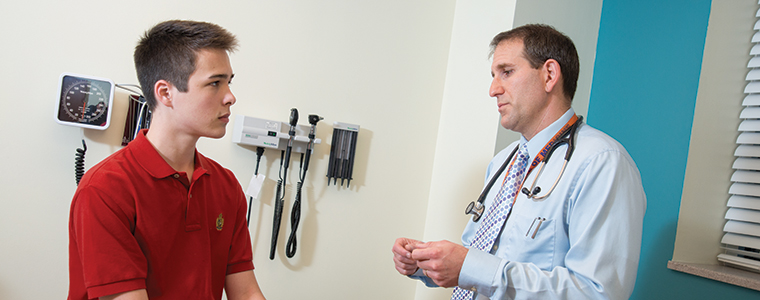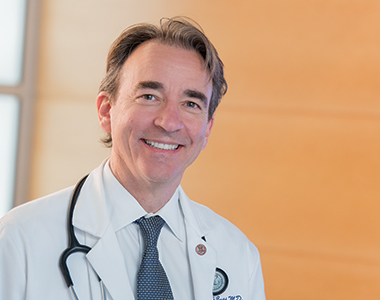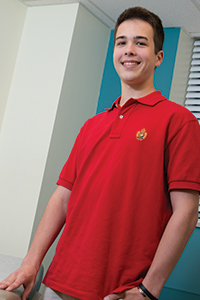Amy and Mike Mangan knew immediately that something was wrong with their son Griffin when he came home to Ocala last September just a month after starting his sophomore year at Florida State University.
“I was taken aback by how he looked. He had clearly lost a lot of weight — he didn’t look healthy,” Amy says. “We thought perhaps he was stressed, that he had a crazy schedule. He’s a conscientious student, so perhaps he was working really hard. Maybe he had a virus.”
When Griffin stepped on a scale and they realized their son had lost 20 pounds, they rushed him to an emergency clinic. There, he was so dehydrated it took nine attempts to draw blood. The results were disturbing. Griffin’s blood sugar was 399 milligrams per deciliter. Normal is 70 to 100 before eating. The clinic sent him straight to the nearby hospital.
At the hospital, Griffin told doctors he was always thirsty, so he drank a lot, and urinated a lot. He was tired, but he chalked it up to the new semester.
“The symptoms just showed up, and I hadn’t thought much about them before I came home,” Griffin says.
But to the doctors, those symptoms pointed to a serious problem — Griffin had type 1 diabetes.
“The diagnosis came out of nowhere,” Amy says. “It was such a shock.”
It took just a few minutes online for Amy to find some of the nation’s leading diabetes researchers 40 miles up the road at the University of Florida. Griffin was admitted to UF Health Shands, a place the Mangans know well. Their daughter, Gillian, is treated at UF Health for epilepsy.
At UF Health, Griffin landed in the hands of a team led by researcher Mark Atkinson, who says Griffin’s case highlights the insidious nature of diabetes, which can strike seemingly healthy people out of the blue.
“In type 1, 85 percent of the time there’s no family history of diabetes, so it’s shocking when it is diagnosed,” says Atkinson, the American Diabetes Association Eminent Scholar for Diabetes Research.
Atkinson has spent more than 30 years at UF, building an interdisciplinary foundation to tackle one of the most intractable diseases of our time. He and Desmond Schatz, co-medical director, pediatric diabetes and president-elect of the American Diabetes Association, are among the top 10 type 1 diabetes researchers in the world, according to Expertscape, a health information website.
While UF has a long history of diabetes research, in 2014 the university officially pulled all of that research together with the launch of the UF Diabetes Institute, with Atkinson as director and Schatz as medical director. The institute brings together nearly 100 faculty members from the colleges of Medicine, Engineering, Public Health and Health Professions, Nursing, Liberal Arts and Sciences, the Institute of Food and Agricultural Sciences, and UF Health Jacksonville.
UF traces its diabetes roots to 1968, when Dr. Arlen Rosenbloom was recruited from the University of Wisconsin as the university’s first pediatric endocrinologist. Rosenbloom subsequently recruited other diabetes experts, like Janet Silverstein and Noel Maclaren.
When Atkinson, fresh out of his undergraduate program, approached Maclaren about joining his research team, Maclaren first sent him to the Florida Camp for Children and Youth with Diabetes.
“My eyes were opened,” Atkinson says. “I didn’t know much about diabetes then, I just thought I’d hate to take shots, and not be able to eat what I want. But I saw the impact of diabetes, how it’s there with you 24/7 … I wanted to make a difference.”
Atkinson says Maclaren offered this advice: “If you pursue three avenues of investigation and find out their answers, you will make a valuable contribution to type 1 diabetes — determine what causes type 1 diabetes; identify a means to predict, months to years in advance, who will develop the disease; and develop a method to cure type 1 diabetes.”
“I can say with both a sense of happiness and sadness that these three avenues remain a major focus of my research efforts,” Atkinson says. “Happiness, in that progress has been made toward each goal, but at the same time none have been fully addressed.”
UF researchers were among the first to understand the cascade of events that result in type 1 diabetes, which improved the means to predict those at increased risk to develop the disease.
Type 1, or insulin-dependent, diabetes occurs when white blood cells vital to the body’s defenses against infectious diseases launch a self-directed or “autoimmune” attack on insulin-producing beta cells in the pancreas. The insulin these beta cells produce regulates how the body uses and stores sugar and other food nutrients for energy.
Teddy

Endocrinologist Michael Haller — Griffin’s physician — is in the midst of a 15-year study called The Environmental Determinants of Diabetes in Youth, or TEDDY, in the Department of Pediatrics. The study is tracking some 8,000 youth at high risk of developing type 1 diabetes. The researchers review the participants’ blood draws, urine, fingernail and hair samples, diet and vaccine histories and illness records in an attempt to pin down what happens in a person’s environment that triggers the immune system to attack their beta cells.
“There’s any number of potential pathways to get the immune system attacking beta cells,” Haller says. “It may not be a single event – it may be any number of events or a collection of events. Being able to parse those out is why type 1 diabetes is so challenging.”
Haller also recently completed a pilot study of two drugs. The first, Thymoglobulin, knocks out attacking immune system cells. The other, Neulasta, helps produce new, healthy immune cells.
After one year, participants who received the combination therapy were still producing insulin at baseline levels while the insulin production of participants who received a placebo decreased by 40 percent. The international diabetes research network TrialNet will launch the study in a larger, national population.
Research has shown that the pancreas is a resilient organ and more than half of its insulin-producing beta cells must be irreversibly destroyed before an individual develops the kinds of symptoms Griffin experienced — frequent urination and increased fluid and food consumption. While these symptoms appear abruptly, the disease process itself takes months or even years to occur.
The goals of UF diabetes research today are the same as when Atkinson began his career. The difference is UF’s breadth and depth. From clinicians to researchers to social workers to teachers, nearly every department that can contribute to diabetes research is involved, Atkinson says. The interdisciplinary approach has turned UF into a hub for diabetes work and has attracted a cadre of talented researchers and grants.
“This makes our program quite unique in terms of its kind within the United States,” Atkinson says.
When he started diabetes research in the early 1980s, Atkinson says, “people thought a cure for type 1 diabetes was right around the corner.”
Indeed, many diabetes advocates viewed the 1990s as the “decade of the cure” for type 1 diabetes. Genetic advances, new drugs to aid in organ transplants, and new animal models for research all fueled optimism.
But the months turned into years, and the years turned into decades, and although great leaps have been made in disease management and in tests to predict who might get the disease, the cause and the cure have proven elusive.
“As time went on, it got later and later in the ‘90s, and there was no cure,” Atkinson says. “You can look back now and could argue that researchers were naïve, but there was a lot of optimism at the time.
“Diabetes is a tough nut to crack. It is much more complex than we ever thought decades ago,” he adds.
Although the current environment is the most difficult he has seen for obtaining research funding, Atkinson says the UF Diabetes Institute continues to attract significant grants, creating a synergy in its research enterprise, and renewed optimism.
“Now, more than any other time in my career, people are collaborating, they are pooling resources, pooling ideas to tackle diabetes together,” Atkinson says.
Last fall, four UF researchers received a total of more than $10 million in grants from the National Institute of Diabetes and Digestive and Kidney Diseases, part of the National Institutes of Health, on top of funding in 2013 of a five-year program to Atkinson of nearly $18 million from the Juvenile Diabetes Research Foundation, or JDRF. The JDRF funding supported nPOD, the Network for Pancreatic Organ Donors with Diabetes, which gives scientists the opportunity to work with human pancreatic tissue rather than mouse models.
Atkinson says UF formed nPOD in 2007 because “existing data from human pancreases was mostly from older studies that didn’t factor in modern technologies available today.
“Until nPOD, research primarily involved rodent models of the disease. But this has limitations because rodents only partially reproduce the human condition and several key questions cannot be investigated unless using human tissue.”
About 150 projects from 17 countries currently rely on nPOD, with 38 projects added in 2014 alone. Atkinson says it’s a team approach pioneered by diabetes researchers and now modeled in other health care arenas.
While a cause and cure remain unsolved, advances in treatment are changing lives.
“In the generation before me, if a child developed type 1 diabetes, the parents might be told their child would live into their 20s or 30s but wouldn’t have a long life, or women would be advised against having children. The innovations of the 1950s, ’60s and ‘70s changed those dogmas. But even in the 1980s and ‘90s, statistics told us diabetes was the leading cause of blindness in adults and the major cause of limb amputation, and it reduced lifespan by two decades,” Atkinson says.
“Data emerging in even the last year show a very different picture,” he adds. “If you have access to diabetes supplies, health care education, and follow the advice given, the risk of complications plummets. Because of medical advances, the story is not so bleak.”
Atkinson says advances in the technology of diabetes care — insulin pumps, simple and fast blood tests, several varieties of insulin — have improved the lives of diabetes patients, at least in the United States.
Globally, the picture is different, ranging from very good to quite grim. Atkinson and his wife, Carol, work with Insulin for Life USA, the world’s second largest not-for-profit provider of free diabetes supplies to developing countries. Atkinson, president of the organization, says the growing program helps about 5,000 patients a year.
“For those with type 1 diabetes, not having access to insulin is a death sentence,” Atkinson says. “Even if you stay alive with limited access to insulin, the complications that are rare here are rampant in other parts of the world.”
Atkinson tells how Insulin for Life USA provided insulin for a girl in India, who nevertheless died at 12. The diagnosis of diabetes made her unsuitable as a marriage partner, and parents feared the supply of insulin might be unreliable, so they did not treat her diabetes.
“For much of the developing world, what we view as a mere treatment and find unacceptable is considered a cure, because it keeps people alive,” Atkinson says.
While progress is being made on type 1 diabetes, the number of people with the more common type 2, or insulin resistant, diabetes continues to skyrocket. (See sidebar story below)
In the United States, one in five health care dollars is spent by someone diagnosed with type 1 or type 2 diabetes, according to the American Diabetes Association. Research by Atkinson and colleagues in 2010 placed the costs of type 1 diabetes at $14.4 billion, and the ADA estimates costs for all forms of diabetes hit $245 billion in 2012.
“The public at large doesn’t understand diabetes. They think the worst part is that you can’t eat what you want, or you take a pill, and you’re OK,” Atkinson says. “They think, ‘Diabetes? Meh.’ Diabetes isn’t ‘meh.’”
For young adults like Griffin, diabetes can be particularly challenging, as they transition from the regular care of a pediatrician and the watchful eyes of parents to start college or a job. Many are living in dorms or sharing apartments. For them, a diabetes diagnosis is a curveball.
“It’s an awkward time for anybody, but if you have type 1 diabetes, it’s a really awkward time,” Atkinson says. “Having diabetes sucks, it really stinks. It’s never good to have diabetes.”
Still, Atkinson says, “If you have to have the disease there is no better time in history than now, at least in the United States.”
For now, Griffin is learning to live with his new companion.
“I was completely ignorant of the disease at first,” Griffin said. “It was a really big learning curve for the first month.”
He’s adjusted his eating habits, cutting out sweet tea. He checks his blood sugar before each meal, and before he runs or goes to rugby practice. Recently, Griffin met with a UF nutritionist to make sure he was correctly estimating his carbohydrate consumption.
Griffin’s final new routine? Checking in with his mother, to whom he texts his blood glucose levels each time he measures them.
At the UF Diabetes Institute, Atkinson says, Griffin is backed by a team ready to help. Although no one in his own family has diabetes, Atkinson says children who took part in research trials in the 1980s now come back to him to screen, and possibly treat, their children.
“We have generations of the same family coming back to us for research and clinical care,” says Atkinson. “I have hundreds of family members with diabetes.”
Type 2 Diabetes
Kenneth Cusi, chief of the Division of Endocrinology, Diabetes and Metabolism and adult medical director for the Diabetes Institute, focuses on the burgeoning issue of type 2 diabetes.
A 2010 study by Novo Nordisk, one of the leading producers of insulin medications, predicted a 64 percent increase in the number of Americans living with diabetes — diagnosed and undiagnosed — by 2025.

In type 2 diabetes, the body either no longer produces enough insulin to maintain normal glucose levels, or the insulin it does produce cannot properly break down glucose. Nearly 30 million people in the United States have type 2 diabetes, according to the 2014 National Diabetes Statistics Report. Another 86 million have prediabetes, with its elevated blood sugar, and 15 to 30 percent of them will develop type 2 diabetes within five years, according to the Centers for Disease Control and Prevention.
UF Endocrinology Clinics now treat about 7,000 diabetes patients annually, prompting Cusi and his team to create a diabetes care task force of nurses, pharmacists, nutritionists and diabetes educators, among others. The task force meets weekly to review cases and learn about the latest research.
Cusi is an expert on another condition that predisposes people to type 2 diabetes: nonalcoholic fatty liver disease, which afflicts about 100 million people in the United States. The disease and its more severe counterpart, nonalcoholic steatohepatitis, are caused by a buildup of fat in the liver. About two-thirds of people who are obese have nonalcoholic fatty liver disease.
“In obesity, it’s not just that you have more fat — you have a sick, or dysfunctional, fat. This fat doesn’t behave normally, but releases a number of adipokines, or proteins, and fatty acids into the bloodstream,” Cusi says.
At UF’s Institute of Food and Agricultural Sciences, Professor Linda Bobroff and colleagues have developed a self-management education program for adults with type 2 diabetes called “Take Charge of Your Diabetes.” The program — which includes 11 lessons focused on standards of medical care in diabetes, self-monitoring of blood glucose, diabetes medications, nutritional management, exercise and others — is implemented at extension offices throughout Florida in collaboration with local health professionals.
“We know that positive lifestyle changes can reduce the incidence of health complications among adults with diabetes, but it’s a challenge to reach all of those who can benefit from a self-management education program,” says Bobroff, state extension nutrition specialist.
Sources:
- Mark Atkinson, Professor of Pathology, Immunology and Laboratory Medicine
- Desmond Schatz, Professor of Pediatrics
Related Website:
This article was originally featured in the Spring 2015 issue of Explore Magazine.


